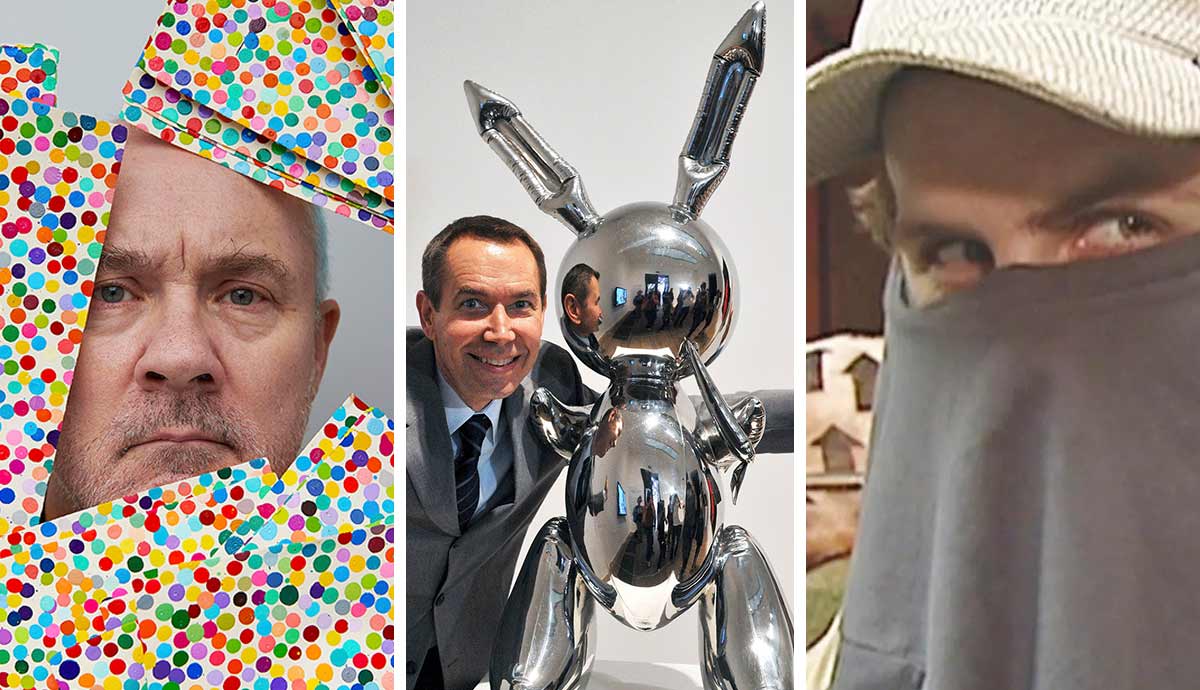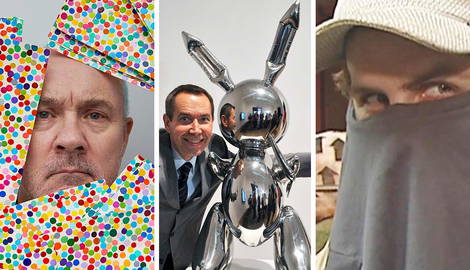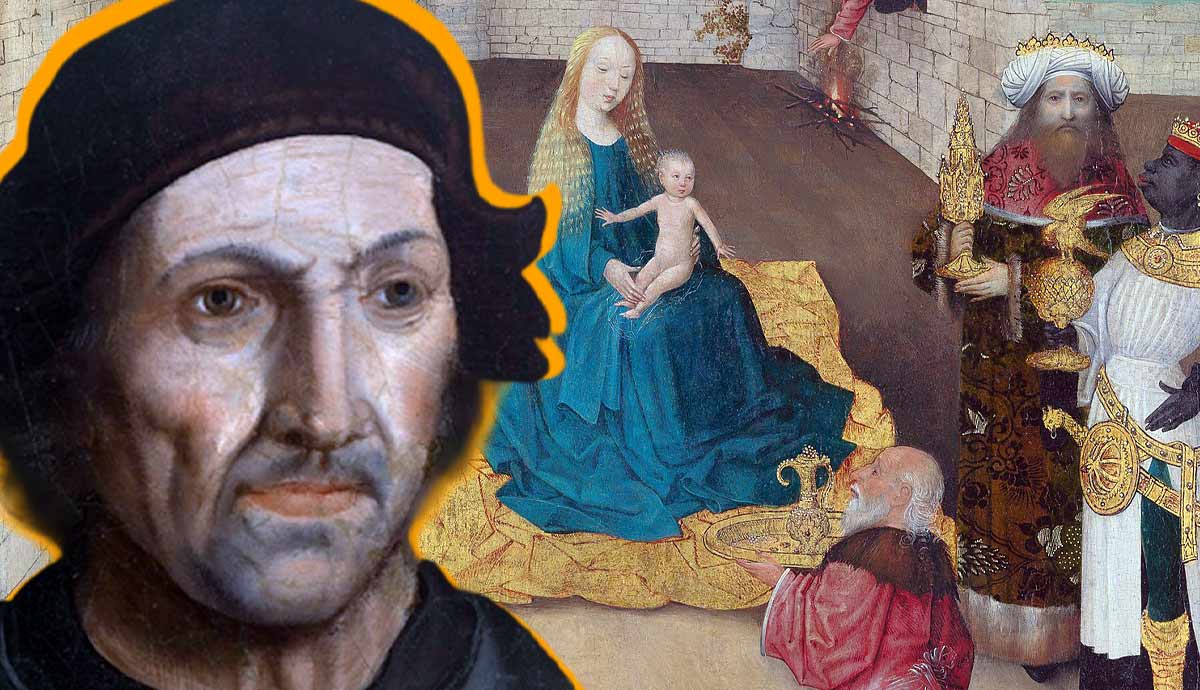
Can bad art be successful? And what is bad art actually? The art world often receives criticism for its snobbish elitism and disconnection from reality. Sometimes, the public can favor someone despised by the critics and vice versa. Critics can praise the most hated artist, provoking public outrage. The definitions of high and low art, or good and bad art, are feeble and sometimes allow for even the most controversial artists to achieve commercial success. Read on to learn more about the most hated famous artists.
1. Damien Hirst: The Most Hated Famous Artist

English contemporary artist Damien Hirst is one of the most famous, successful yet hated artists of the present day. He is often accused of commercializing art, putting more emphasis on the monetary value rather than on the artistic one. The main topics present in Hirst’s art are mortality and impermanence. However, the artist has provoked outrage due to the controversial methods he uses for the exploration of these themes.

The most famous and recognizable work made by Damien Hirst, The Physical Impossibility of Death in the Mind of Someone Living, consists of a dead shark preserved in formaldehyde inside a glass tank. Many critics and gallery visitors call the work repulsive and meaningless. They believe that Hirst relies on shock value in place of quality artistic expression. Apart from the questionable aesthetic qualities of the work, Hirst’s shark also raises concerns of animal rights activists.
Initially, Hirst ordered a shark from an Australian fisherman, who shipped it to London. Despite the amounts of formaldehyde used, the shark started to decay while on display, and required replacement. Initially, the gallery staff skinned the shark and stretched its skin over a metal carcass, but Hirst was not satisfied with the result, ordering yet another animal to be caught and killed. This was neither the first nor the last time Damien Hirst used dead animals for his installations. Overall, according to independent research, during the decades of his career, almost one million different creatures, including cows, horses, zebras, and butterflies, died in order to appear in his works. His enthusiasm about digital art, cryptocurrency, and NFTs also raised concerns of those troubled by the commercialization of art and the diluting sense of artistic merit.
2. Jeff Koons: The Balloon Master and Provocateur

American artist Jeff Koons presents himself as the heir of Marcel Duchamp and Andy Warhol who reinvents everyday objects and raises concerns about the authenticity and accessibility of art. In Warhol-esque fashion, he also delegates the creation of his pieces to his assistants in the studio. His most famous works are bright balloon dogs which explore the contrasts between expected and actual materiality, weight, price, and importance. According to Koons, his engagement with inflated toys and animals simultaneously represents childish naivety and adult sexuality, world exploration, and the dark corners of the psyche.

However, despite being loved by millions, Koons is also one of the most hated artists worldwide. He is constantly attacked for his kitschy style and shameless self-promotion that often relies on outdated and insensitive imagery. The peak of his questionable egocentric exploration was the series of pornographic photographs of Koons and his then-wife, the Italian porn star Ilona Staller. The series was presented under the cheeky title Made in Heaven. Apart from the obvious explicit content and the exploitation of patriarchal stereotypes, the series was published at the height of the AIDS crisis. Because of this, it was labeled as cruel and irresponsible. On the surface, Koons’ art is apolitical to the point of insensitivity. Many critics accused Koons of catering to the needs of wealthy art collectors and dealers with no thought about the political or ethical implications of his works.
3. Margaret Keane: The Woman Behind Big Eyes Paintings

Margaret Keane was a painter raised in a conservative religious environment who gained prominence during one of the biggest art scandals of the past century. For more than a decade, her husband Walter Keane made a name for himself by attributing Margaret’s paintings of sad big-eyed children to himself. Walter, who hardly knew how to paint, claimed that he saw these kids during his visit to post-war Europe. He told people how he was struck by the pain and trauma that was present on children’s faces.
Walter was uncompromisingly egocentric, calling himself the greatest painter of eyes since El Greco and putting himself into the same category next to the great masters of the past like Michelangelo and Leonardo da Vinci. While Walter was promoting his paintings and wasting his enormous revenues on parties, Margaret was locked in her studio, working 16 hours a day to paint new works. The paintings were a huge success, with both originals and printed copies sold in hundreds and thousands.

Margaret found the courage to speak up only several years after her separation from Keane and after her move to Hawaii. A subsequent court trial proved Margaret’s authorship, cementing her reputation as the original creator of painted big-eyed children. Despite the media buzz around both Keanes, their artistic reputation among the art establishment remained highly controversial. Art critics openly hated the works, calling them kitschy and creepy. They were also worried about the growing number of imitators and followers. Keane’s work gathered a huge fanbase among the newly emerged American middle class settling in the suburbs. Despite the criticism of art curators, Andy Warhol stated that Keane’s art could not be so bad if so many people liked it.
4. Richard Serra: The Underappreciated Minimalist

Minimalism, despite its simple and similarly understandable nature, remains one of the most controversial art movements in the history of art. The American sculptor Richard Serra blended the Minimalist conceptual framework with the idea of site-specific works, exploring the relationship between the location and the art piece placed in it. His main sculptural influences came from the works of Romanian artist Constantin Brancusi and the Italian movement of Arte Povera which focused on cheap found materials instead of traditional, expensive ones. Serra is one of the most important American artists of the past century, but not all of his artistic experiments were appreciated by the public.

The most famous and most controversial work by Serra was placed in the middle of New York City’s Federal Plaza. In 1981, Serra constructed a curved and leaning piece Tilted Arc to be placed on a square of a business district. It stayed there for eight years. The sculpture aimed to reinvent the ways people interacted with the space, and alter their everyday patterns. However, the office workers did not show much enthusiasm for this.
The 120-foot-long panel made from rust-covered steel ruined regular walking paths used by local inhabitants and forced them to walk extra distances. Many people believed that it also ruined the space aesthetically by blocking the view of streets and buildings around it. After eight years of legal battles, the sculpture was removed and placed in the artist’s warehouse. Upset by the outcome, Serra stated that he would never exhibit Tilted Arc since it was intended for the Federal Plaza only.
5. Banksy: The Most Famous Rebel of the Art World

Banksy hardly needs an introduction. He is one of the most famous artists of the century and certainly the most famous street artist ever. However, he remains both loved and hated since the earliest days of his work. One of the key features of Banksy’s persona is his relative anonymity. He never appears in public and settles his affairs through a group of representatives. However, rumors of his true identity have been circulating for years, with recently uncovered interviews proving some of them. Over the years, the potential candidates included several celebrities and a couple of lesser-known British artists.

Banksy’s works are found in various locations around the world. His street art pieces are often connected to current political events from around the world. According to the artist, he wants to spread anti-capitalist and anti-establishment messages. He also wants to criticize the bigotry and hypocrisy of the art world and the elites. However, behind the rebellious facade, many critics saw his not-so-subtle desire to be accepted by that same establishment he was making fun of. Banksy’s art is sold at auctions for millions, so it makes no real difference since it is catering to the same commercial system as the rest of successful contemporary artists and he profits from it. Thus, his seemingly radical rebellion offers no real alternative. Instead, it fuels the same system it aims to dismantle.










